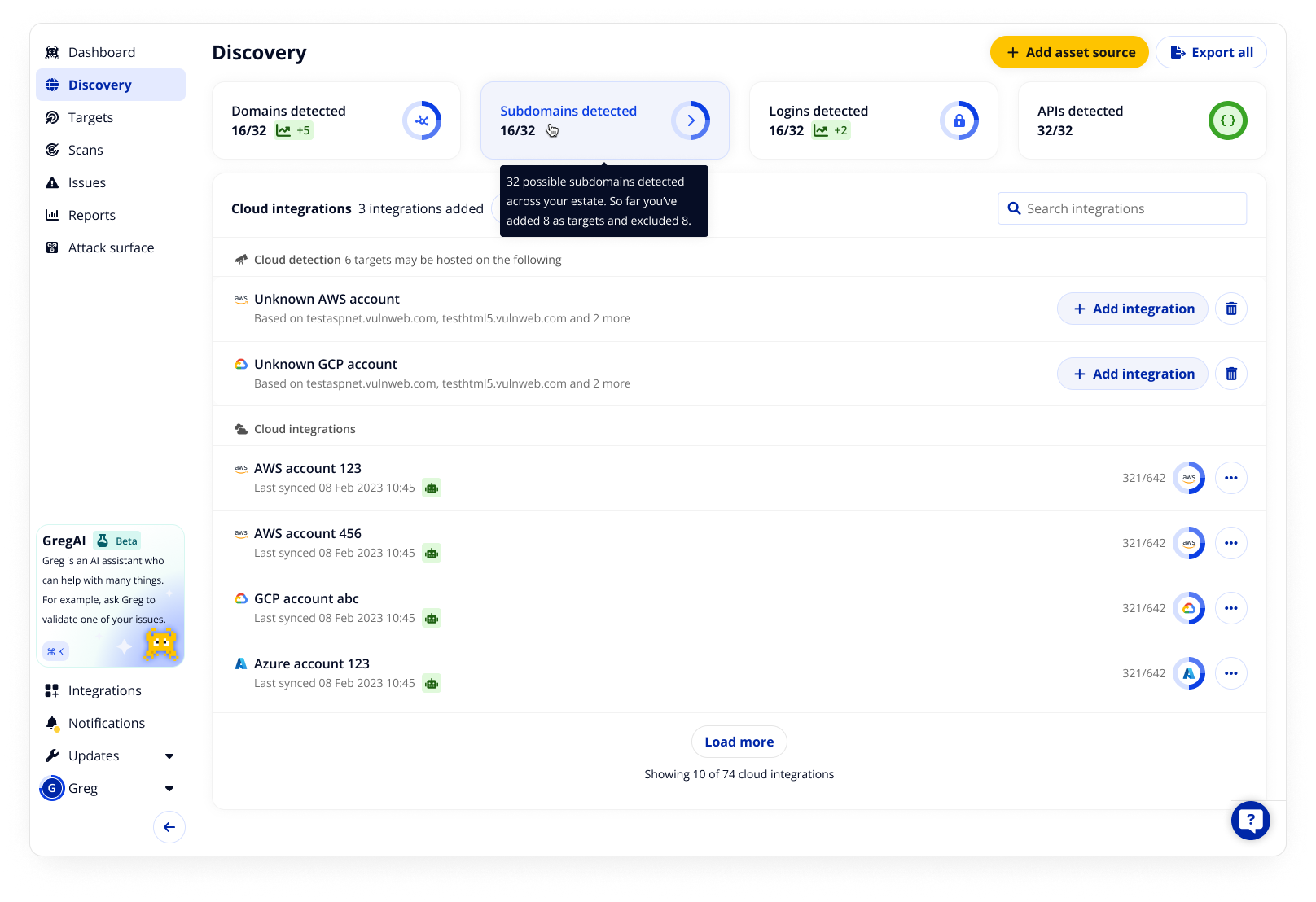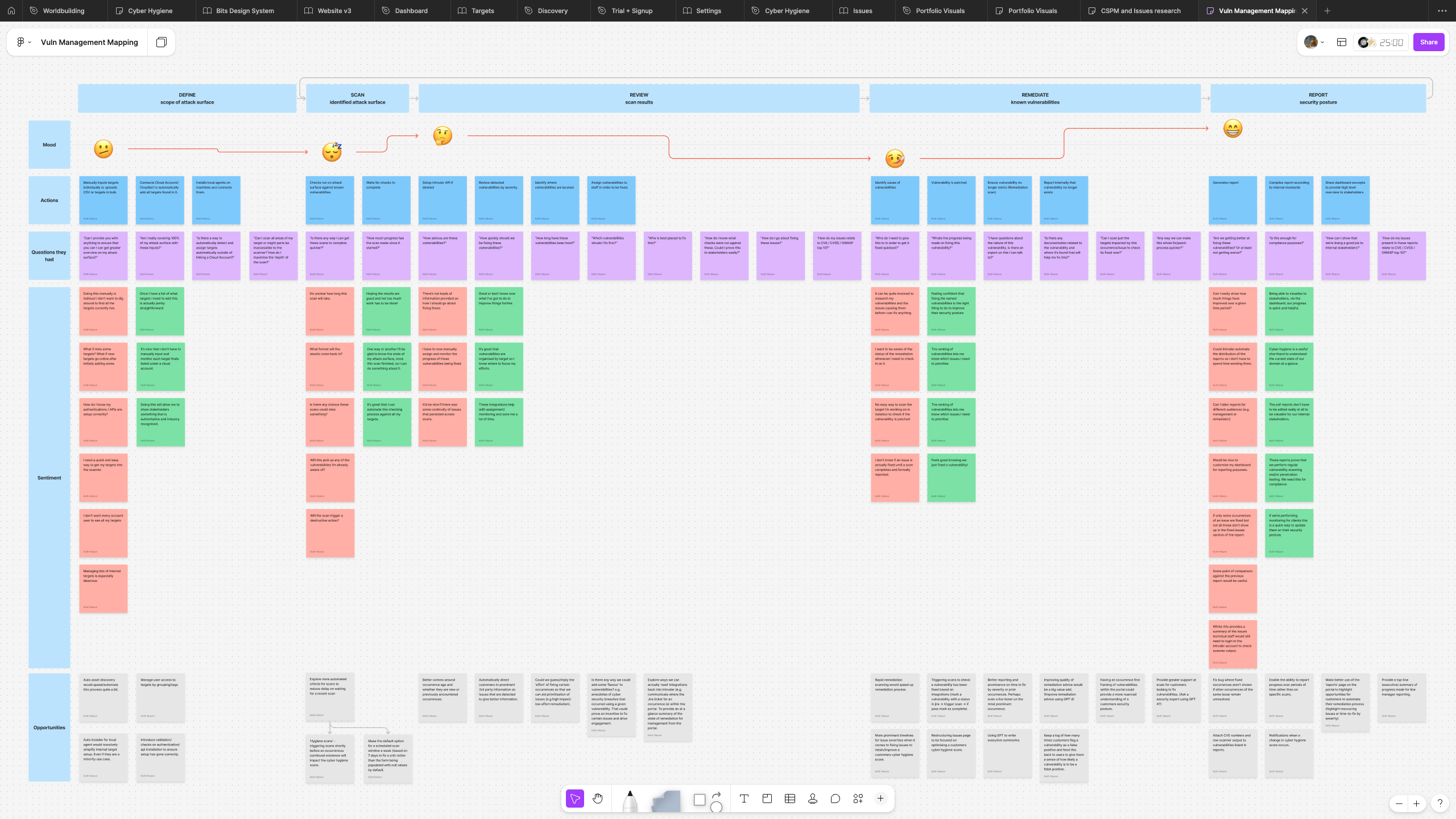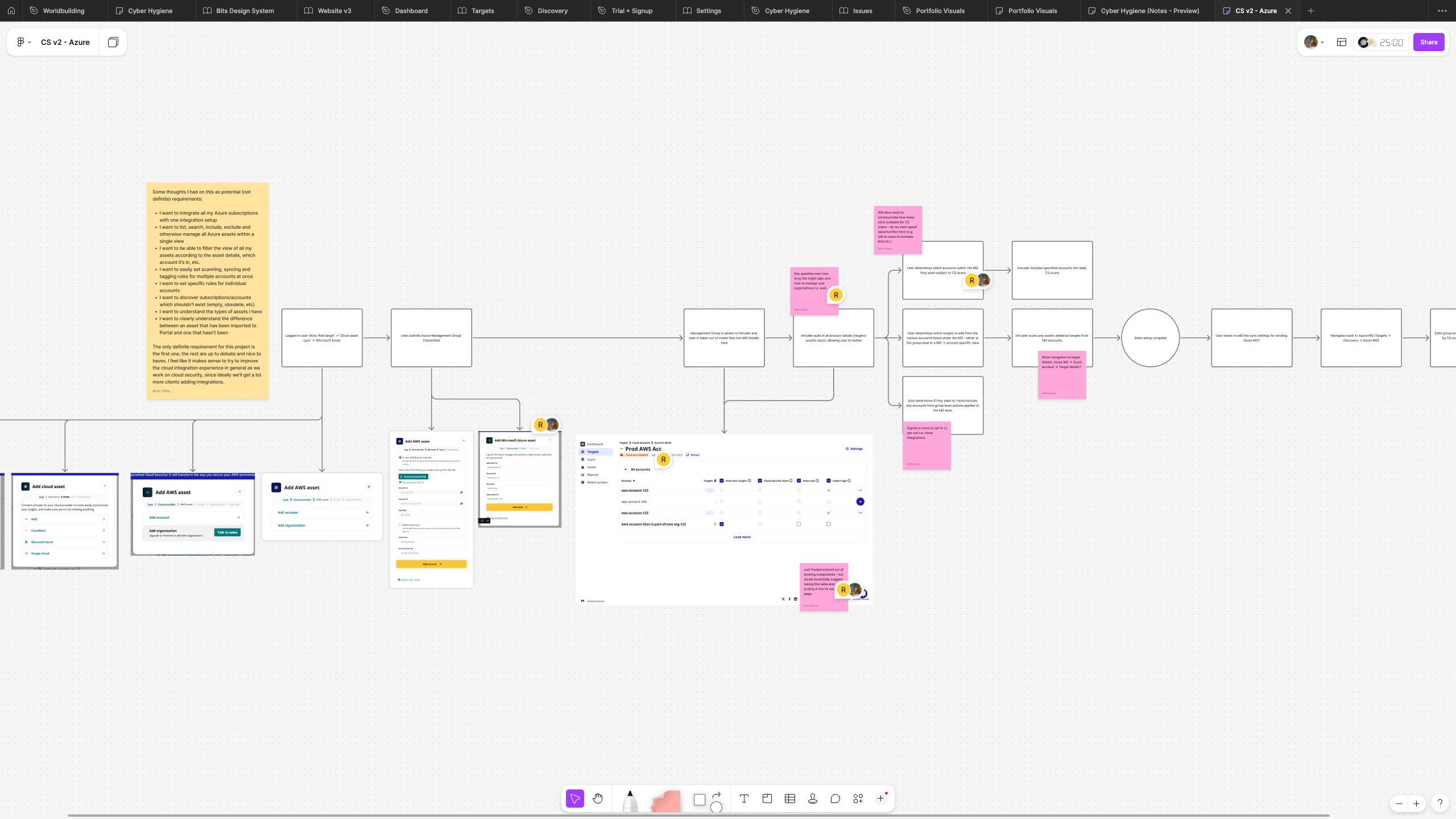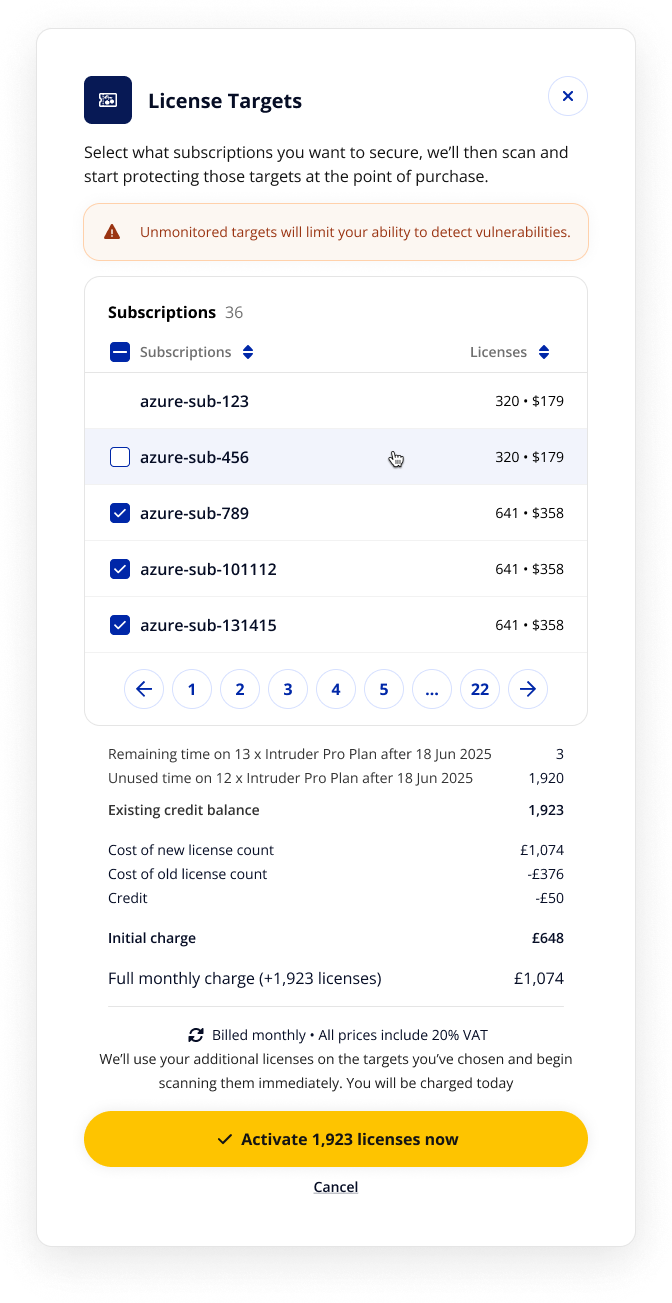How better asset discovery drove 17x integration adoption
Strategic UX Leadership
Systems Thinking
Cross-Functional Leadership

Overview
The Asset Discovery feature at Intruder was fragmented, focused on standalone cloud subscriptions and often underutilised. It was critical to helping users batch-import targets which we could then monitor for security exploits.
I led a strategic redesign to broaden its capability, enabling whole-directory imports and additional discovery methods, while elevating the feature as a core part of the product.
The result was a simplified customer experience, faster asset onboarding, and stronger alignment with our revenue model (licenses).
Involvement
Lead designer
~2 month duration (Jul - Aug ‘24)
Figma, Posthog, Count and Dovetail.
Impact
+1,700%
Increase in Weekly Cloud Users
+3,900%
Increase in targets Per ICP2 User
+20%
Improvement in integration adoption rates
Context
Asset Discovery was a critical part of vulnerability management, yet it was being severely underutilised. Despite a strong link between early integration adoption and customer retention, only 40% of AWS customers connected their accounts.
The experience itself explained much of the problem. It was:
- Slow and repetitive → enterprise customers had to connect accounts one subscription at a time, even when managing hundreds.
- Hidden → the feature was tucked away, disconnected from core workflows.
- Anxiety-inducing → customers worried about losing control over license consumption.
- Outdated → the UI neglected better performing design patterns used elsewhere in the platform.
This was the existing page for our discovery feature set, buried in a tab under Targets and was lagging in both form and function.

Clicking on an integration on the old page would take you to some version of what was internally called the subscription settings page.

Goals & Success Metrics
Our primary objectives were clear: double cloud integration adoption among trial users, reduce median days to fix, increase weekly active cloud users (WAUCU), and boost the number of cloud targets scanned per user.
Behind these targets sat a broader strategic vision: to transform Asset Discovery from a peripheral feature into the core entry point of the platform, a shift designed to accelerate time-to-value while expanding scanning coverage.

We interviewed key customers who used the feature set regularly.

We plotted out the existing user journey around discovering and adding new targets to identify and get agreement on the main opportunities.
We did a teardown on the existing journey highlighting the areas the toolset was failing customers and to better understand the bottlenecks that existed.

Research & Discovery
Through customer interviews, two critical pain points emerged. Enterprise customers needed scale, the ability to add entire directories, not just individual subscriptions. At the same time, they faced license anxiety, worrying that uncontrolled license consumption would spiral out of their hands.
The key insight was clear: customers wanted a bulk import capability paired with granular control over which assets would consume licenses.
The redesigned discovery page that we introduced as part of the project.

The redesigned subscription view we released during the project

The new directory view we introduced as part of the project.

One of the big changes seen in this project was us moving from adding individual subscriptions to entire directories of subscriptions at once. So we needed to reflect this in our design and ensure the workflow facilitated this increased scale.
Solution Strategy
Our solution strategy combined structural changes to the product with targeted user experience improvements.
On the structural side, we elevated Discovery to the top-level navigation, redesigned it to handle directory-scale operations (hundreds of subscriptions instead of one-by-one), and built a modular UI system to support multiple discovery methods. We also introduced a Universal Container Header to bring portal-wide consistency.
From a user experience perspective, we introduced bulk operations, allowing entire directories of subscriptions to be added at once. We gave customers clear license control, with visibility into which assets would consume licenses before committing. We added contextual upselling, the first direct license purchase flow within the relevant workflow, and applied progressive disclosure, streamlining installation so customers only needed minimal input to get started.
Implementation & Rollout

Releases: → 1. New installation flow (minimal customer friction) → 2. Directory overview interface → 3. Subscription management revision → 4. Core directory page redesign
We built integrations following customer demand. Implementing Microsoft Azure, Amazon Web Services, Google Cloud Platform. We then monitored adoption metrics, customer feedback, and support insights throughout, iterating rapidly based on real usage patterns.
Impact
The redesign led to a dramatic increase in adoption. Weekly cloud integration users grew by 1,700% (17x), while targets added per user skyrocketed by 3,900% (39x). This translated into a massive expansion of coverage, with far more assets monitored per customer.
The business impact was equally significant. We unlocked the first in-portal upsell opportunity, enabling direct license purchases within the target import workflow. Coverage expansion also drove pipeline growth, with higher-value deals entering the funnel. Most importantly, customers reached time-to-value faster, with more high-stakes vulnerabilities detected early in their journey.
Strategic Outcomes
The project delivered a clear product transformation. Asset Discovery shifted from a hidden utility into a core strength of the platform, built on a scalable foundation for enterprise customer acquisition. Along the way, we created reusable UI components that improved consistency across the entire portal.
The revenue impact was just as strong. The new direct upsell pathway opened up fresh expansion opportunities, while higher asset coverage supported premium customer acquisition. By reducing friction, we also accelerated trial-to-paid conversion, strengthening the growth engine.
Key Learnings
A few key learnings stood out from the project. First, scale assumptions matter, designing for individual accounts versus entire directories completely changes the user experience requirements.
Second, we found that control reduces anxiety. When customers had clear transparency into license impact, adoption increased significantly.
Third, context drives conversion. Upselling proved most effective when embedded directly within the user’s workflow.
Finally, infrastructure enables growth. By investing in modular design systems, we laid the groundwork to accelerate future feature development.

A major customer pain-point around expansion was Intruder allocated licenses to targets at random when a scan was started. Meaning customers couldn’t manually assign licenses.
To address this I proposed the introduction of a variant upsell pathway that allowed the user to:
- Select cloud accounts containing targets,
- Purchase the exact amount of licenses needed to cover those targets
- Immediately trigger a scan on just those targets.
This ensured the licenses went onto those targets, giving the customer what they wanted and drove substantial MoM revenue for Intruder.
Want to chat?
I’m always interested to hear about new opportunities, chances to collaborate,
or even just ideas people are exploring. Let’s connect.
How better asset discovery drove 17x integration adoption
Strategic UX Leadership
Systems Thinking
Cross-Functional Leadership

Overview
The Asset Discovery feature at Intruder was fragmented, focused on standalone cloud subscriptions and often underutilised. It was critical to helping users batch-import targets which we could then monitor for security exploits.
I led a strategic redesign to broaden its capability, enabling whole-directory imports and additional discovery methods, while elevating the feature as a core part of the product.
The result was a simplified customer experience, faster asset onboarding, and stronger alignment with our revenue model (licenses).
Involvement
Lead designer
~2 month duration (Jul - Aug ‘24)
Figma, Posthog, Count and Dovetail.
Impact
+1,700%
Increase in Weekly Cloud Users
+3,900%
Increase in targets Per ICP2 User
+20%
Improvement in integration adoption rates
Context
Asset Discovery was a critical part of vulnerability management, yet it was being severely underutilised. Despite a strong link between early integration adoption and customer retention, only 40% of AWS customers connected their accounts.
The experience itself explained much of the problem. It was:
- Slow and repetitive → enterprise customers had to connect accounts one subscription at a time, even when managing hundreds.
- Hidden → the feature was tucked away, disconnected from core workflows.
- Anxiety-inducing → customers worried about losing control over license consumption.
- Outdated → the UI neglected better performing design patterns used elsewhere in the platform.
This was the existing page for our discovery feature set, buried in a tab under Targets and was lagging in both form and function.

Clicking on an integration on the old page would take you to some version of what was internally called the subscription settings page.

Goals & Success Metrics
Our primary objectives were clear: double cloud integration adoption among trial users, reduce median days to fix, increase weekly active cloud users (WAUCU), and boost the number of cloud targets scanned per user.
Behind these targets sat a broader strategic vision: to transform Asset Discovery from a peripheral feature into the core entry point of the platform, a shift designed to accelerate time-to-value while expanding scanning coverage.

We interviewed key customers who used the feature set regularly.

We plotted out the existing user journey around discovering and adding new targets to identify and get agreement on the main opportunities.
We did a teardown on the existing journey highlighting the areas the toolset was failing customers and to better understand the bottlenecks that existed.

Research & Discovery
Through customer interviews, two critical pain points emerged. Enterprise customers needed scale, the ability to add entire directories, not just individual subscriptions. At the same time, they faced license anxiety, worrying that uncontrolled license consumption would spiral out of their hands.
The key insight was clear: customers wanted a bulk import capability paired with granular control over which assets would consume licenses.
The redesigned discovery page that we introduced as part of the project.

The redesigned subscription view we released during the project

The new directory view we introduced as part of the project.

One of the big changes seen in this project was us moving from adding individual subscriptions to entire directories of subscriptions at once. So we needed to reflect this in our design and ensure the workflow facilitated this increased scale.
Solution Strategy
Our solution strategy combined structural changes to the product with targeted user experience improvements.
On the structural side, we elevated Discovery to the top-level navigation, redesigned it to handle directory-scale operations (hundreds of subscriptions instead of one-by-one), and built a modular UI system to support multiple discovery methods. We also introduced a Universal Container Header to bring portal-wide consistency.
From a user experience perspective, we introduced bulk operations, allowing entire directories of subscriptions to be added at once. We gave customers clear license control, with visibility into which assets would consume licenses before committing. We added contextual upselling, the first direct license purchase flow within the relevant workflow, and applied progressive disclosure, streamlining installation so customers only needed minimal input to get started.
Implementation & Rollout

Releases: → 1. New installation flow (minimal customer friction) → 2. Directory overview interface → 3. Subscription management revision → 4. Core directory page redesign
We built integrations following customer demand. Implementing Microsoft Azure, Amazon Web Services, Google Cloud Platform. We then monitored adoption metrics, customer feedback, and support insights throughout, iterating rapidly based on real usage patterns.
Impact
The redesign led to a dramatic increase in adoption. Weekly cloud integration users grew by 1,700% (17x), while targets added per user skyrocketed by 3,900% (39x). This translated into a massive expansion of coverage, with far more assets monitored per customer.
The business impact was equally significant. We unlocked the first in-portal upsell opportunity, enabling direct license purchases within the target import workflow. Coverage expansion also drove pipeline growth, with higher-value deals entering the funnel. Most importantly, customers reached time-to-value faster, with more high-stakes vulnerabilities detected early in their journey.
Strategic Outcomes
The project delivered a clear product transformation. Asset Discovery shifted from a hidden utility into a core strength of the platform, built on a scalable foundation for enterprise customer acquisition. Along the way, we created reusable UI components that improved consistency across the entire portal.
The revenue impact was just as strong. The new direct upsell pathway opened up fresh expansion opportunities, while higher asset coverage supported premium customer acquisition. By reducing friction, we also accelerated trial-to-paid conversion, strengthening the growth engine.
Key Learnings
A few key learnings stood out from the project. First, scale assumptions matter, designing for individual accounts versus entire directories completely changes the user experience requirements.
Second, we found that control reduces anxiety. When customers had clear transparency into license impact, adoption increased significantly.
Third, context drives conversion. Upselling proved most effective when embedded directly within the user’s workflow.
Finally, infrastructure enables growth. By investing in modular design systems, we laid the groundwork to accelerate future feature development.

A major customer pain-point around expansion was Intruder allocated licenses to targets at random when a scan was started. Meaning customers couldn’t manually assign licenses.
To address this I proposed the introduction of a variant upsell pathway that allowed the user to:
- Select cloud accounts containing targets,
- Purchase the exact amount of licenses needed to cover those targets
- Immediately trigger a scan on just those targets.
This ensured the licenses went onto those targets, giving the customer what they wanted and drove substantial MoM revenue for Intruder.
Want to chat?
I’m always interested to hear about new opportunities, chances to collaborate,
or even just ideas people are exploring. Let’s connect.
How better asset discovery drove 17x integration adoption
Strategic UX Leadership
Systems Thinking
Cross-Functional Leadership

Overview
The Asset Discovery feature at Intruder was fragmented, focused on standalone cloud subscriptions and often underutilised. It was critical to helping users batch-import targets which we could then monitor for security exploits.
I led a strategic redesign to broaden its capability, enabling whole-directory imports and additional discovery methods, while elevating the feature as a core part of the product.
The result was a simplified customer experience, faster asset onboarding, and stronger alignment with our revenue model (licenses).
Involvement
Lead designer
~2 month duration
Figma, Posthog, Count and Dovetail.
Impact
+1,700%
Increase in Weekly Cloud Users
+3,900%
Increase in targets Per ICP2 User
+20%
Improvement in integration adoption rates
Context
Asset Discovery was a critical part of vulnerability management, yet it was being severely underutilised. Despite a strong link between early integration adoption and customer retention, only 40% of AWS customers connected their accounts.
The experience itself explained much of the problem. It was:
- Slow and repetitive → enterprise customers had to connect accounts one subscription at a time, even when managing hundreds.
- Hidden → the feature was tucked away, disconnected from core workflows.
- Anxiety-inducing → customers worried about losing control over license consumption.
- Outdated → the UI neglected better performing design patterns used elsewhere in the platform.
This was the existing page for our discovery feature set, buried in a tab under Targets and was lagging in both form and function.

Clicking on an integration on the old page would take you to some version of what was internally called the subscription settings page.

Goals & Success Metrics
Our primary objectives were clear: double cloud integration adoption among trial users, reduce median days to fix, increase weekly active cloud users (WAUCU), and boost the number of cloud targets scanned per user.
Behind these targets sat a broader strategic vision: to transform Asset Discovery from a peripheral feature into the core entry point of the platform, a shift designed to accelerate time-to-value while expanding scanning coverage.

We interviewed key customers who used the feature set regularly.
We plotted out the existing user journey around discovering and adding new targets to identify and get agreement on the main opportunities.
We did a teardown on the existing journey highlighting the areas the toolset was failing customers and to better understand the bottlenecks that existed.

Research & Discovery
Through customer interviews, two critical pain points emerged. Enterprise customers needed scale, the ability to add entire directories, not just individual subscriptions. At the same time, they faced license anxiety, worrying that uncontrolled license consumption would spiral out of their hands.
The key insight was clear: customers wanted a bulk import capability paired with granular control over which assets would consume licenses.
The redesigned discovery page that we introduced as part of the project.

The redesigned subscription view we released during the project

The new directory view we introduced as part of the project.

One of the big changes seen in this project was us moving from adding individual subscriptions to entire directories of subscriptions at once. So we needed to reflect this in our design and ensure the workflow facilitated this increased scale.
Solution Strategy
Our solution strategy combined structural changes to the product with targeted user experience improvements.
On the structural side, we elevated Discovery to the top-level navigation, redesigned it to handle directory-scale operations (hundreds of subscriptions instead of one-by-one), and built a modular UI system to support multiple discovery methods. We also introduced a Universal Container Header to bring portal-wide consistency.
From a user experience perspective, we introduced bulk operations, allowing entire directories of subscriptions to be added at once. We gave customers clear license control, with visibility into which assets would consume licenses before committing. We added contextual upselling, the first direct license purchase flow within the relevant workflow, and applied progressive disclosure, streamlining installation so customers only needed minimal input to get started.
Implementation & Rollout

Releases: → 1. New installation flow (minimal customer friction) → 2. Directory overview interface → 3. Subscription management revision → 4. Core directory page redesign
We built integrations following customer demand. Implementing Microsoft Azure, Amazon Web Services, Google Cloud Platform. We then monitored adoption metrics, customer feedback, and support insights throughout, iterating rapidly based on real usage patterns.
Impact
The redesign led to a dramatic increase in adoption. Weekly cloud integration users grew by 1,700% (17x), while targets added per user skyrocketed by 3,900% (39x). This translated into a massive expansion of coverage, with far more assets monitored per customer.
The business impact was equally significant. We unlocked the first in-portal upsell opportunity, enabling direct license purchases within the target import workflow. Coverage expansion also drove pipeline growth, with higher-value deals entering the funnel. Most importantly, customers reached time-to-value faster, with more high-stakes vulnerabilities detected early in their journey.
A major customer pain-point around expansion was Intruder allocated licenses to targets at random when a scan was started. Meaning customers couldn’t manually assign licenses.
To address this I proposed the introduction of a variant upsell pathway that allowed the user to:
- Select cloud accounts containing targets,
- Purchase the exact amount of licenses needed to cover those targets
- Immediately trigger a scan on just those targets.
This ensured the licenses went onto those targets, giving the customer what they wanted and drove substantial MoM revenue for Intruder.

Strategic Outcomes
The project delivered a clear product transformation. Asset Discovery shifted from a hidden utility into a core strength of the platform, built on a scalable foundation for enterprise customer acquisition. Along the way, we created reusable UI components that improved consistency across the entire portal.
The revenue impact was just as strong. The new direct upsell pathway opened up fresh expansion opportunities, while higher asset coverage supported premium customer acquisition. By reducing friction, we also accelerated trial-to-paid conversion, strengthening the growth engine.
Key Learnings
A few key learnings stood out from the project. First, scale assumptions matter, designing for individual accounts versus entire directories completely changes the user experience requirements.
Second, we found that control reduces anxiety. When customers had clear transparency into license impact, adoption increased significantly.
Third, context drives conversion. Upselling proved most effective when embedded directly within the user’s workflow.
Finally, infrastructure enables growth. By investing in modular design systems, we laid the groundwork to accelerate future feature development.
Want to chat?
I’m always interested to hear about new opportunities, chances to collaborate,
or even just ideas people are exploring. Let’s connect.